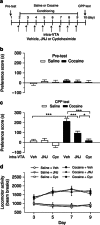Metabotropic glutamate receptor I (mGluR1) antagonism impairs cocaine-induced conditioned place preference via inhibition of protein synthesis
- PMID: 23348064
- PMCID: PMC3656374
- DOI: 10.1038/npp.2013.29
Metabotropic glutamate receptor I (mGluR1) antagonism impairs cocaine-induced conditioned place preference via inhibition of protein synthesis
Abstract
Antagonism of group I metabotropic glutamate receptors (mGluR1 and mGluR5) reduces behavioral effects of drugs of abuse, including cocaine. However, the underlying mechanisms remain poorly understood. Activation of mGluR5 increases protein synthesis at synapses. Although mGluR5-induced excessive protein synthesis has been implicated in the pathology of fragile X syndrome, it remains unknown whether group I mGluR-mediated protein synthesis is involved in any behavioral effects of drugs of abuse. We report that group I mGluR agonist DHPG induced more pronounced initial depression of inhibitory postsynaptic currents (IPSCs) followed by modest long-term depression (I-LTD) in dopamine neurons of rat ventral tegmental area (VTA) through the activation of mGluR1. The early component of DHPG-induced depression of IPSCs was mediated by the cannabinoid CB1 receptors, while DHPG-induced I-LTD was dependent on protein synthesis. Western blotting analysis indicates that mGluR1 was coupled to extracellular signal-regulated kinase (ERK) and mammalian target of rapamycin (mTOR) signaling pathways to increase translation. We also show that cocaine conditioning activated translation machinery in the VTA via an mGluR1-dependent mechanism. Furthermore, intra-VTA microinjections of mGluR1 antagonist JNJ16259685 and protein synthesis inhibitor cycloheximide significantly attenuated or blocked the acquisition of cocaine-induced conditioned place preference (CPP) and activation of translation elongation factors. Taken together, these results suggest that mGluR1 antagonism inhibits de novo protein synthesis; this effect may block the formation of cocaine-cue associations and thus provide a mechanism for the reduction in CPP to cocaine.
Figures









Similar articles
-
Caveolin-1 knockout mice exhibit impaired induction of mGluR-dependent long-term depression at CA3-CA1 synapses.Proc Natl Acad Sci U S A. 2010 Dec 14;107(50):21778-83. doi: 10.1073/pnas.1015553107. Epub 2010 Nov 23. Proc Natl Acad Sci U S A. 2010. PMID: 21098662 Free PMC article.
-
Examination of a role for metabotropic glutamate receptor 5 in the medial prefrontal cortex in cocaine sensitization in rats.Psychopharmacology (Berl). 2012 May;221(1):91-100. doi: 10.1007/s00213-011-2548-1. Epub 2011 Nov 16. Psychopharmacology (Berl). 2012. PMID: 22147256
-
Activation of the phosphoinositide 3-kinase-Akt-mammalian target of rapamycin signaling pathway is required for metabotropic glutamate receptor-dependent long-term depression.J Neurosci. 2004 Jul 14;24(28):6352-61. doi: 10.1523/JNEUROSCI.0995-04.2004. J Neurosci. 2004. PMID: 15254091 Free PMC article.
-
Using metabotropic glutamate receptors to modulate cocaine's synaptic and behavioral effects: mGluR1 finds a niche.Curr Opin Neurobiol. 2013 Aug;23(4):500-6. doi: 10.1016/j.conb.2013.01.009. Epub 2013 Feb 4. Curr Opin Neurobiol. 2013. PMID: 23385114 Free PMC article. Review.
-
Roles for Arc in metabotropic glutamate receptor-dependent LTD and synapse elimination: Implications in health and disease.Semin Cell Dev Biol. 2018 May;77:51-62. doi: 10.1016/j.semcdb.2017.09.035. Epub 2017 Oct 14. Semin Cell Dev Biol. 2018. PMID: 28969983 Free PMC article. Review.
Cited by
-
CB1-Dependent Long-Term Depression in Ventral Tegmental Area GABA Neurons: A Novel Target for Marijuana.J Neurosci. 2017 Nov 8;37(45):10943-10954. doi: 10.1523/JNEUROSCI.0190-17.2017. Epub 2017 Oct 16. J Neurosci. 2017. PMID: 29038246 Free PMC article.
-
VTA mTOR Signaling Regulates Dopamine Dynamics, Cocaine-Induced Synaptic Alterations, and Reward.Neuropsychopharmacology. 2018 Apr;43(5):1066-1077. doi: 10.1038/npp.2017.247. Epub 2017 Oct 17. Neuropsychopharmacology. 2018. PMID: 29039413 Free PMC article.
-
A Review of Molecular Imaging of Glutamate Receptors.Molecules. 2020 Oct 16;25(20):4749. doi: 10.3390/molecules25204749. Molecules. 2020. PMID: 33081223 Free PMC article. Review.
-
Adaptations in AMPA receptor transmission in the nucleus accumbens contributing to incubation of cocaine craving.Neuropharmacology. 2014 Jan;76 Pt B(0 0):287-300. doi: 10.1016/j.neuropharm.2013.04.061. Epub 2013 May 30. Neuropharmacology. 2014. PMID: 23727437 Free PMC article. Review.
-
mTOR signalling in the nucleus accumbens shell is critical for augmented effect of TFF3 on behavioural response to cocaine.Sci Rep. 2016 Jun 10;6:27895. doi: 10.1038/srep27895. Sci Rep. 2016. PMID: 27282818 Free PMC article.
References
-
- Bellone C, Luscher C. mGluRs induce a long-term depression in the ventral tegmental area that involves a switch of the subunit composition of AMPA receptors. Eur J Neurosci. 2005;21:1280–1288. - PubMed
Publication types
MeSH terms
Substances
Grants and funding
LinkOut - more resources
Full Text Sources
Other Literature Sources
Miscellaneous

